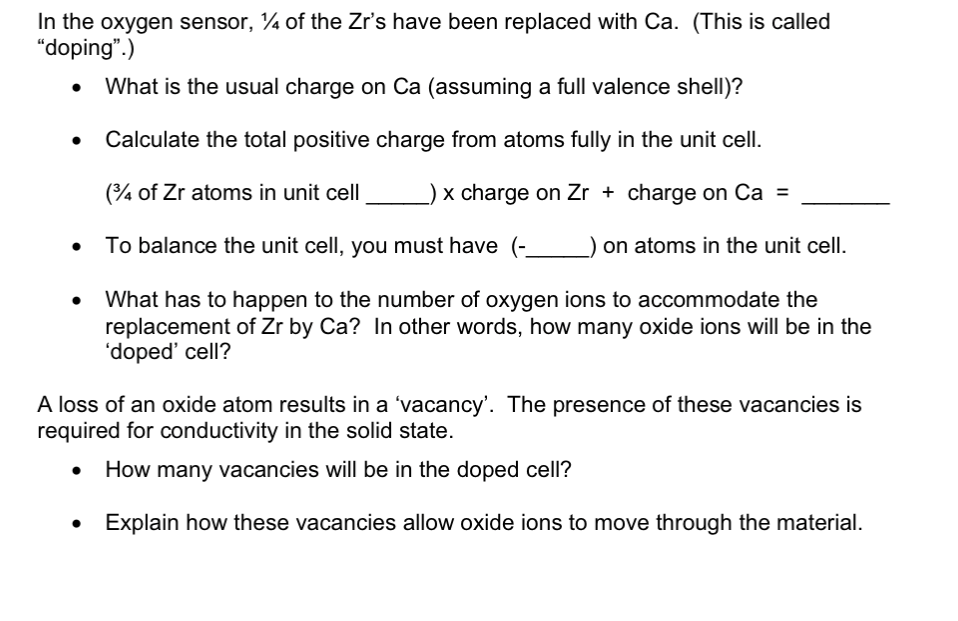Principles of Instrumental Analysis
7th Edition
ISBN:9781305577213
Author:Douglas A. Skoog, F. James Holler, Stanley R. Crouch
Publisher:Douglas A. Skoog, F. James Holler, Stanley R. Crouch
Chapter31: Thermal Methods
Section: Chapter Questions
Problem 31.5QAP
Related questions
Question
Please answer the 6 bullet points. It's all in one question

Transcribed Image Text:In the oxygen sensor, ¼ of the Zr's have been replaced with Ca. (This is called
"doping".)
What is the usual charge on Ca (assuming a full valence shell)?
Calculate the total positive charge from atoms fully in the unit cell.
(4 of Zr atoms in unit cell
x charge on Zr + charge on Ca =
To balance the unit cell, you must have (-
on atoms in the unit cell.
What has to happen to the number of oxygen ions to accommodate the
replacement of Zr by Ca? In other words, how many oxide ions will be in the
'doped' cell?
A loss of an oxide atom results in a 'vacancy'. The presence of these vacancies is
required for conductivity in the solid state.
How many vacancies will be in the doped cell?
Explain how these vacancies allow oxide ions to move through the material.
Expert Solution
This question has been solved!
Explore an expertly crafted, step-by-step solution for a thorough understanding of key concepts.
This is a popular solution!
Trending now
This is a popular solution!
Step by step
Solved in 2 steps with 1 images

Knowledge Booster
Learn more about
Need a deep-dive on the concept behind this application? Look no further. Learn more about this topic, chemistry and related others by exploring similar questions and additional content below.Recommended textbooks for you

Principles of Instrumental Analysis
Chemistry
ISBN:
9781305577213
Author:
Douglas A. Skoog, F. James Holler, Stanley R. Crouch
Publisher:
Cengage Learning

Principles of Modern Chemistry
Chemistry
ISBN:
9781305079113
Author:
David W. Oxtoby, H. Pat Gillis, Laurie J. Butler
Publisher:
Cengage Learning

EBK A SMALL SCALE APPROACH TO ORGANIC L
Chemistry
ISBN:
9781305446021
Author:
Lampman
Publisher:
CENGAGE LEARNING - CONSIGNMENT

Principles of Instrumental Analysis
Chemistry
ISBN:
9781305577213
Author:
Douglas A. Skoog, F. James Holler, Stanley R. Crouch
Publisher:
Cengage Learning

Principles of Modern Chemistry
Chemistry
ISBN:
9781305079113
Author:
David W. Oxtoby, H. Pat Gillis, Laurie J. Butler
Publisher:
Cengage Learning

EBK A SMALL SCALE APPROACH TO ORGANIC L
Chemistry
ISBN:
9781305446021
Author:
Lampman
Publisher:
CENGAGE LEARNING - CONSIGNMENT